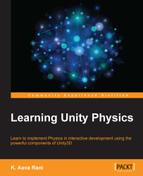In order to understand what it means to implement a Physics component of Unity3D successfully in games and applications, a developer must have a better understanding of the key elements of Physics and their behavior in the engine. I wrote this book to provide a detailed description with examples for learning a Physics component of Unity3D in a way that emphasizes the uniqueness of each component and their implementation.
The successful implementation of Physics in game or application development starts with a strong understanding of each component. When we look at game and application development in Unity3D, it is easy to see that Physics is the most important component. I have provided the conceptual foundation of a Physics component and introduced these using examples for a better understanding.
I had three main goals while writing this book:
- Accuracy: This book is the result of years of experience and research. This book focuses on the Physics components of Unity3D and their implementations.
- Implementation: My experience as a developer has taught me two things about examples: they need to be detailed, and they must help developers do their work. As a result, users of my book will always find abundant examples with every step carefully laid out and explained wherever necessary so that the reader can follow. To describe and explain the Physics of Unity3D, this book uses realistic examples to help developers get inside of what Physics is really like. In addition to the examples, I have provided detailed screenshots and figures for a better understanding. These examples will help developers in the successful implementation of Physics components in their game or application as well as help them identify the best practices they need to adopt to improve their game or application performance.
- A structured approach: I have tried to explain Physics and Unity3D in a reader-friendly way. Most books claim to do this, but my experience with a variety of books has proven otherwise. What students and developers will find in my book are short, precise explanations of terms and concepts that are written in an understandable language. For example, I have used more images rather than text to explain steps of implementations, which gives a better understanding for readers.
Chapter 1, Introduction to Physics in Unity3D, serves as a quick introduction to Physics, and specifically Physics in Unity3D. We will also learn about in-built Physics, as well as Unity3D and the uses of Physics in an interactive development.
Chapter 2, Using Different Colliders for Interaction, focuses on colliders, their types in Unity3D, and how we can define the collision shape of objects in a scene.
Chapter 3, Overview of Collision Matrix, explains matrices, their types, and how we can define a collision shape of objects in a scene explaining a matrix.
Chapter 4, Rigidbody Types and Their Properties, focuses on Rigidbodies and their types in Unity3D.
Chapter 5, Joint Types and Their Properties, describes joints and their types in Unity 3D.
Chapter 6, Animation and Unity3D Physics, gives in-depth knowledge on how to use Physics in animation in Unity3D. We will be developing complex animations and also see some examples of animation using Physics.
Chapter 7, Optimizing Application's Performance Using Physics in Unity3D, teaches you how you can optimize applications and games if you use Physics in Unity3D.
